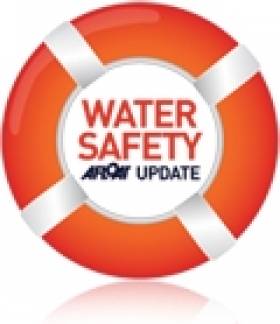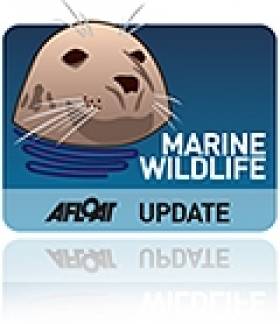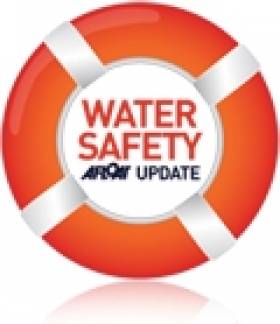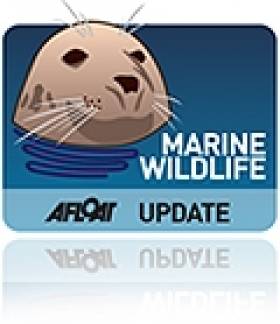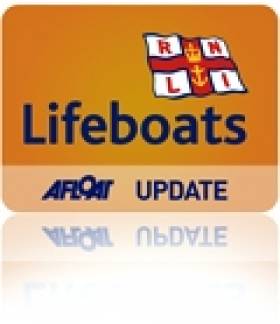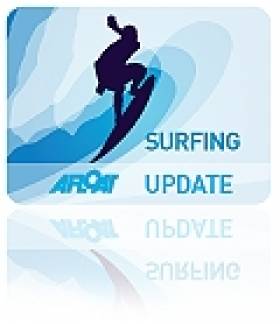Displaying items by tag: Northern Ireland
'Difficulties' For Disabled Anglers In Co Antrim
#Angling - Are developers causing difficulties for disabled anglers in Co Antrim?
That's what the Six Mike Water Trust's Michael Martin has alleged, as Farming Life reports, with claims that housing developments on the Kirbys’ Lane river walk are "destroying the river corridor" at the disabled angling stand.
What's more, a proposed development for 400 homes on the Six Mile Water's flood plain downstream in an area home to a variety of aquatic wildlife is "surely... a contravention to EEC Water Framework and Habitats Directives."
Farming Life has more on the story HERE.
Lifeguards Return To Causeway Coast For Easter Break
#WaterSafety - RNLI lifeguards will be making a welcome return to a number of selected beaches on the Causeway Coast and in Co Down next weekend ahead of the Easter holidays.
After undergoing intensive training in preparation, the charity’s lifeguards will be keeping visitors safe on Tyrella Beach in Co Down and on Benone Strand, Portstewart Strand, East and West Strands in Portrush and Whiterocks on the Causeway Coast.
Lifeguards will begin their patrols on Good Friday (3 April) between 11am and 7pm on the Causeway Coast and between 10am and 6pm in Co Down and continue daily to Sunday 12 April.
Cover will be provided every weekend until the end of June ahead of the summer season, when a daily duty will get underway on all 10 RNLI lifeguarded beaches in Northern Ireland.
"Our lifeguards are looking forward to going on patrol and meeting people who come to the beach," said RNLi lifeguard manager Mick Grocott. "We would encourage visitors to speak to our lifeguards, ask for safety advice, and most importantly call on them should they find themselves in difficulty."
Ahead of Easter, the RNLI has reiterated its advice to people planning a beach trip to stay well away from dangerous cliff edges which have been impacted by recent weather conditions.
Winter storms changed the profile of all the beaches with extensive damage at Whiterocks, Portrush East and Portstewart where there are high and unstable sand cliffs.
The RNLI’s advice for anyone planning a trip to the beach is to: check weather and tide times before you go and if planning to go into the water; only go swimming at a lifeguarded beach, between the red and yellow flags; and avoid using inflatables in strong winds or rough seas.
If you get into trouble, stick your hand in the air and shout for help and if you see someone else in trouble, tell a lifeguard. If you can’t see a lifeguard, call 909 or 112 and ask for the coastguard.
For more safety information on the beach you plan to visit, you can download the RNLI’s Beachfinder app to find lifeguarded beaches and more information.
#MarineWildlife - New marine protections for Northern Ireland's waters could provide a further sanctuary for our smallest marine mammal, the harbour porpoise.
As the Belfast Telegraph reports, the proposed Marine Conservation Zone (MCZ) for the area between Belfast Lough and Carlingford Lough would join the Causeway Coast zone protected in 2012.
The news comes some months after the European Commission put pressure on Westminster to designate more protected areas for the smallest of Ireland's cetaceans, whose swimming grounds are being encroached by offshore wind farm development.
And the new proposals for Northern Irish waters also include protections for important seabird colonies as well as an area of seagrass that's vital to local biodiversity.
But the overall scale of the UK's MCZ plans, reduced from more than 100 proposed zones to a total of 50 over the past two years, has been criticised by conservation groups for betraying a 'lack of ambition'.
The Belfast Telegraph has more on the story HERE.
#WaterSafety - The RNLI is advising anyone planning on visiting its lifeguarded beaches on the North Coast to stay well away from dangerous cliff edges that have been impacted by recent weather conditions.
Winter storms have dramatically changed the profile of beaches at Whiterocks, Portrush East and Portstewart, creating high sand cliffs that are unstable. RNLI lifeguard manager Mike Grocott is asking the public to be mindful of the changes ahead of making a visit.
"Winter storms have taken their toll on the make-up of some of the beaches this year, particularly at Whiterocks, Portrush East and Portstewart, and many people returning to these favourite spots may be surprised at how different everything looks.
"This includes significant erosion of the sand dunes where gentle slopes have washed away leaving sheer sand cliffs, some of which are up to 18 feet high.
"Access points have been altered and on some beaches the shifting sand has left deep channels that in turn create strong rip currents.
"We would encourage anyone planning a trip to one of these beaches to put safety first and be mindful that these sand cliffs are falling away and may be unstable. The best advice is to stay away from the sand cliff edges and bases."
Meanwhile, RNLI lifeguards are busy preparing for a new season where they will be patrolling 10 beaches in Northern Ireland during the summer. Last year RNLI lifeguards responded to 251 incidents, assisting 284 people.
Beach Safety Programmes For Northern Ireland Schools
#WaterSafety - The RNLI is encouraging primary schools in Northern Ireland to sign up for two of its beach safety education programmes when they get under way next month.
Running from March to June, Meet the Lifeguards and Hit the Surf aim to educate pupils in P5-P7 on the importance of beach safety in a fun and practical way.
Meet the Lifeguards gives pupils the opportunity to participate in an informative and interactive session when RNLI lifeguards visit their school. The 45-minute presentation focuses on equipping pupils with key safety advice that they can put to use when they visit a beach with family and friends.
Pupils will learn more about the RNLI, the charity that saves lives at sea and the role of the RNLI lifeguard on the beach. They will be educated on what the different beach safety flags and signs mean; the safety of using inflatables while swimming; and how to identify natural and man-made hazards. They will also learn about body boarding and surfing safety, rip currents and how to escape them and safety information on tides and waves.
Hit the Surf, meanwhile, offers a unique opportunity for school children to get practical lessons in lifesaving and beach safety at one of the 10 RNLI lifeguarded beaches located on the north coast and in Co Down.
The session, which lasts two-and-a-half hours, includes a theory lesson on staying safe at the beach and the role of the RNLI and its lifeguards. It's followed by practical lessons in lifesaving and surf-based skills while building pupils confidence in the sea. The pupils will also learn about local hazards and the beach environment.
RNLI lifeguard supervisor Tim Doran is encouraging schools to get involved. "Education and prevention are an important part of the RNLI’s work and programmes such as Meet the Lifeguards and Hit the Surf enable us as lifeguards to deliver important beach safety advice in a way that is both informative and engaging," he says.
"We hope that pupils can then take what they learn, share it with family and friends and use it to have fun in a safe way when they visit a beach."
Last year, RNLI lifeguards in Northern Ireland responded to 251 incidents, assisting 284 people.
"With the profile of the beaches changing after winter storms, the RNLI lifeguards were kept busy in 2014," says Doran. "With rip currents and changing landscapes, the lifeguards engaged in a large amount of preventative work, speaking to beach users and advising of the safest places to swim."
For more information on how to book your school onto an RNLI education programme, please contact 028 7087 8492 or email [email protected]
#MarineWildlife - Columba, the young loggerhead turtle rescued from near freezing waters on the Donegal coast last week, has died.
As the Belfast Telegraph reports, staff at the Exploris aquarium in Portaferry fought hard to save the junior turtle's life after it was discovered hundreds of miles from the warmer waters of the Gulf Stream, but it sadly passed away on Monday night (26 January).
A post-mortem was scheduled to determine whether illness may have caused the 12-year-old reptile to veer so far off course into Ireland's dangerously cold winter waters.
But for every sad story, the marine wildlife rehab staff at Exploris have many more happy tales to tell.
Since 1989, the Co Down aquarium has rescued 187 common seals, 253 grey seals and 10 loggerheads, with the vast majority returned to the wild in full health.
And they've come to the sanctuary from all over Ireland, with 1990 in particular being a big year for rescues of loggerhead turtles at Achill Island, Galway Bay and Brandon Bay, the aquarium's first.
There are some unusual rescue animals, too, such as a white lobster found in Carnlough in Co Antrim four years ago. The Belfast Telegraph has much more HERE.
Ireland's RNLI Lifeboats Rescued More Than 1,400 People In 2014
#RNLI - Ireland's RNLI lifeboat crews launched 1,089 times in 2014, bringing 1,414 people to safety.
And the lifesaving charity is calling for the public to think ahead and never underestimate the strength and power of the sea and inland waters as it today releases its 2014 lifeboat launch and rescue statistics, based on detailed returns of service, from each of its 45 lifeboat stations in Ireland.
The figures show more people are getting into difficulty on leisure craft, and the RNLI advises that proper safety advice and maintenance is vital to ensure people stay safe on the water.
The busiest lifeboat station on the island of Ireland last year was Lough Ree RNLI in Athlone. The charity’s lifeboat crew there launched 69 times and brought 142 people to safety.
This was followed by Howth RNLI, which had 62 launches and brought 107 people to safety, making it their busiest year ever.
Dun Laoghaire RNLI in south Dublin launched 56 times and brought 55 people to safety, while lifeboat crews on the Aran Islands off Galway and Arranmore Island off Donegal launched 78 times, helping 80 people.
Enniskillen RNLI on Lough Erne, which operates two separate lifeboat stations on the upper and lower lough, also had a busy year with 59 calls for assistance and 57 people brought ashore.
Elsewhere in Northern Ireland, Bangor RNLI in Co Down was the busiest single site station, launching 49 times and helping 51 people. Portrush RNLI on the Antrim coast launched their lifeboats 31 times and brought 28 people to safety.
In all, RNLI lifeboats in Northern Ireland launched 261 times in 2014, bringing 281 people to safety, while the charity’s lifeguards helped 284 people on 10 beaches during the season.
Compared to the previous year, when they launched 255 times, NI lifeboat launches show a slight increase. A total of 36 more people were brought to safety by RNLI lifeboats in 2014.
While lifeboat launch figures throughout the island of Ireland remain largely the same as last year, there has been a 10% increase in the amount of people brought to safety by lifeboats.
The types of callouts that the RNLI responded to last year included aid to leisure craft users (536), assistance to fishing vessels (140), help to people who got into difficulty along the shoreline (119) and to people in the water (185).
"These figures are based on every lifeboat station in the RNLI returning a detailed service report and are a valuable insight into what our volunteer lifeboat crews are facing when they launch and what conditions they face," said RNLI operations manager Owen Medland.
"Overall 35% of our lifeboat callouts were carried out in the hours of darkness. Almost half of the callouts last year were to leisure vessels and of these callouts many were to groundings and engine problems.
"Breaking down at sea or on a lough can be a frightening experience. Weather and darkness can turn a bad situation very serious in a matter of minutes. Nobody who sets out thinks anything bad will happen but calling for help early is always the right choice."
Medland continued: "Our volunteer lifeboat and shore crews have shown the commitment and courage we have come to rely on them for, but we must also thank our supporters and fundraisers, who work tirelessly to ensure the charity, which is dependent on donations from the public continues.
"There are also hundreds of employers around the country who let our lifeboat crews drop what they are doing and respond to a callout. We would not be able to run this service without them and we are extremely grateful to them for that."
Last year also saw the introduction of the RNLI’s 45th lifeboat station in Ireland, when Union Hall RNLI in south west Cork went on trial for a 24-month period in November.
And in the coming months, Lough Swilly RNLI in Buncrana, Co Donegal will become the first station in Ireland to receive the new Shannon-class lifeboat.
The €2.4 million lifeboat, which is due to arrive later this year, is the first class of lifeboat to be named after an Irish river, recognition by the charity of the role of Irish lifeboat crews and volunteers throughout the history of the RNLI.
In 2014 the charity marked 190 years of lifesaving and the RNLI is aiming to reduce coastal drowning significantly by 2024.
To do this, it will be expanding its preventative work and will launch Respect the Water, engaging with water users on how to stay safe and maintain their equipment. Water safety advice is available on rnli.org/safety.
Portrush Brothers Pioneer 'Next Generation' Surfboards
#Surfing - "Next generation" surfboards are the stock-in-trade of Portrush brothers Chris and Ricky Martin, whose Skunk Works business gets The Irish Times profile treatment this week.
The brothers' company is a first for Northern Ireland, let alone its Coleraine base, but they're taking advantage of a growing thirst for surfing across the island's top surfing spots.
That's particularly strong on the North Antrim coast – home turf of big wave surfer Al Mennie – and the northwest, from Donegal to Sligo, where the biggest waves attract the best in the world.
And the Martins' revolutionary concept – a custom method of manufacturing stronger foam surfboards to withstand the rigours of the waves – is appealing far beyond the North, with the brothers fielding interest internationally from the industry's leading lights.
The Irish Times has much more on the story HERE.
Exploris Sees In New Year With Seal Pup Rescue
#MarineWildlife - A moulting seal pup is in good hands at Northern Ireland's only seal sanctuary after being separated from its mother in Strangford Lough.
As the Belfast Telegraph reports, the pup – one of many orphaned in the lough during bad weather – is being cared for by the experts at the Exploris aquarium and marine wildlife sanctuary in Portaferry, which itself was saved from closure after local councillors agree to a £1 million funding package last autumn.
#Missing - On New Year's Day emergency teams entered the third day of a search and rescue operation on the north Down coast for a woman missing from her Bangor home since Monday 29 December.
According to the Belfast Telegraph, a member of the public reported that the woman – in her early 30s, and believed to have experienced a recent bereavement – had swum out into open water, leaving a bag of clothes at a pier in the town on the southern shore of Belfast Lough.
A major search operation was launched with the coastguard and RNLI lifeboats joined by Lagan Search and Rescue, a fishery patrol and a PSNI helicopter, but this was scaled back on Wednesday to two search boats and a team of coastguard volunteers searching on land.
Elsewhere in Northern Ireland, the search for a missing Monaghan man in Enniskillen entered its 17th day yesterday (2 January), with the Belfast Telegraph highlighting the "extraordinary" level of community support behind the volunteer effort.
Kieran McAree is thought to have entered Lough Erne after abandoning his car in the Fermanagh town in the early hours of 17 December, and now the search is focused on recovering his body.
But even as recently as last weekend more than 300 people joined in the search in their own boats and kayaks to cover a wide area of the lough, with PSNI Constable Gavin Huey telling the Impartial Reporter: "This is the biggest search I have ever witnessed on Lough Erne."



























